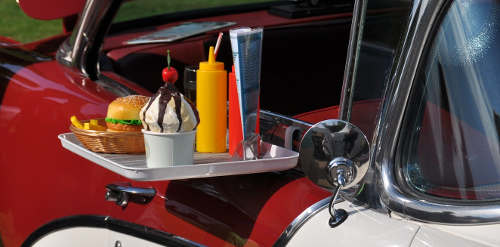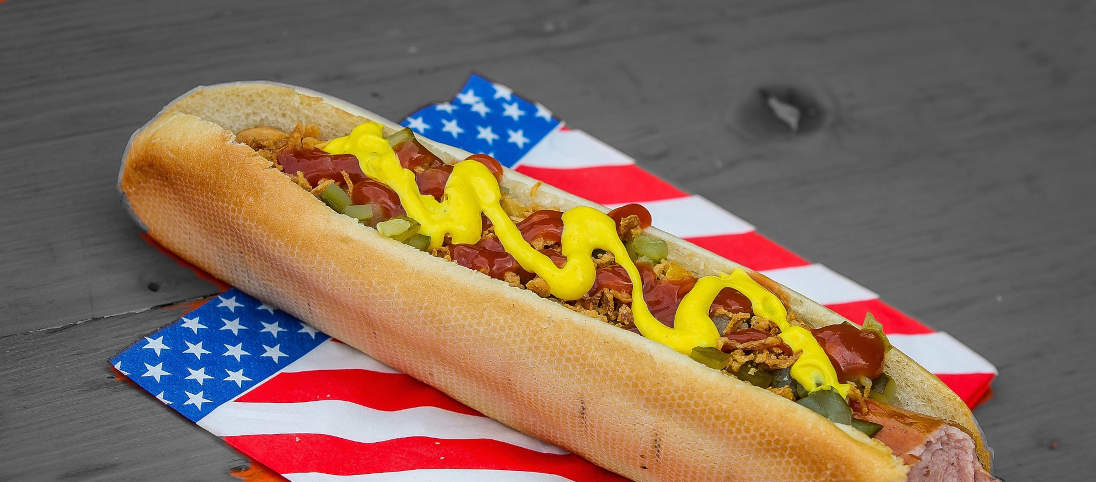Advanced level English
Fast
food is one of those things that the USA has "given" to the world. But
while hamburgers and fries are seen worldwide as being typically
American, in actual fact Americans did not invent fast food - they just
made it into a lifestyle.
 Fast food can even be eaten in
the car.
Fast food can even be eaten in
the car.Before Ronald McDonald was even born, the British were into hot fast food, in the form of fish 'n' chips. Precursors of today's drive-thru, sit-down or carry-out burger restaurants and other fast-food outlets, British fish 'n' chip shops had for many years been offering customers a real meal to eat in the street. In the olden days, people ate fish 'n' chips wrapped in old newspaper, and used their fingers to eat them with.
Other forms of fast food were common all over the world too; the "packed lunch", some bread and something to eat with it, was part of the daily routine of millions of industrial and agricultural workers all over Europe and North America for over a century.
American-style "fast food" took existing models, and refined them, to create a new style of eating adapted to the high-speed mobile life-styles of the modern age.
As its name implies, a "Hamburger" was originally a German dish that originated in Hamburg (and has nothing to do with ham, in spite of modern derivatives such as chicken-burger and beefburger). Its repackaging as the most popular type of fast food was however an American achievement, as America was the first nation in the world to master modern methods of large scale food production, distribution and conservation (notably deep freezing).
Even in the 1960's, steak was still an expensive luxury for most people in Europe; but in America it was already an everyday dish. Furthermore, fast food outlets, offering cheap cooked meals, corresponded ideally to the needs of an increasingly mobile and increasingly busy society.
In the sixties, American lifestyles were far ahead of those of most Europeans; but since then, Europe has caught up. Ronald McDonald's Golden Arches have sprung up in and around virtually every big town and city in Europe, and across much of the rest of the world too; and even such typically "American" styles of fast food, such as Tex-Mex, are following in the international traces of the hamburger franchises, thanks to television and the popularity of American youth culture.
Americans can no doubt be forgiven for saying such things as "It's as American as pizza". Even if this other classic dish is of Mediterranean origin, it is America that has spread its popularity around the world.
WORDS
worldwide: all over the world - precursor: something that comes before - outlets : shops, points of sale - customer: client - repackage: present something in a different way - dish: meal - a franchise: a shop or restaurant that pays to use a famous name - to forgive: to pardon
Printing: Ready to print
Copyright © Linguapress. Do not copy this document to any other website
Copying permitted for personal study, or by teachers for use with their students.
STUDENTS' WORKSHEET
The American way of eating
Using information from the article, write factual sentences starting with the following prompts:1.
Ronald McDonald
2. Newspaper
3.Every day
4. Large scale food production
5. European lifestyles
6. American youth culture
7. Pizzas
2. Newspaper
3.Every day
4. Large scale food production
5. European lifestyles
6. American youth culture
7. Pizzas
For teachers
Note that there are a few small differences between the audio recording and the written text. These mostly concert synonyms. Make sure that students notice them.Cambridge Advanced English style multiple choice cloze exercise
The following exercise can be given to students as a CAE-style reading comprehension test before you present the document in class.The origins of Fast Food
Americans did not invent "fast food", any more than they invented cars or television; they were just the (a last b fastest c first) to refine it into an art, and spread the art worldwide.
Before Ronald McDonald was (a even b ever c over) born, the British were into hot fast food, in the (a form b size c name) of fish 'n' chips. Precursors of today's drive-thru, sit-down or carry-out burger restaurants and other fast-food (a inlets b omelettes c outlets) , British fish 'n' chip shops had for many years been (a offered b offering c offer) customers a real meal to eat in the (a bed b street c village) . In the olden days, people ate fish 'n' chips wrapped in old (a plastic b clothes c newspaper) , and used their fingers to eat them with.
Other forms of fast food were common all over the world too; the "packed (a box b lunch c sack)" , some bread and something to eat with it, was part of the (a only b really c daily ) routine of millions of industrial and agricultural workers all over Europe and North America for over a ( a week b century c year).
American-style "fast food" took existing models, and refined them, to create a new style of ( a eating b eat c eaten) adapted to the high-speed mobile life-styles of the modern age.
As its name implies, a "Hamburger" was originally a German ( a man b dish c food) that originated in Hamburg (and has (a something b nothing c anything) to do with ham, in spite of modern derivatives such as chicken-burger and beefburger). Its repackaging as the most popular type of fast food was however an American (a answer b action c achievement) , as America was the first nation (a in b of c into) the world to master modern methods of large scale (a eat b feed c food) production, distribution and conservation (notably deep freezing).
Americans did not invent "fast food", any more than they invented cars or television; they were just the (a last b fastest c first) to refine it into an art, and spread the art worldwide.
Before Ronald McDonald was (a even b ever c over) born, the British were into hot fast food, in the (a form b size c name) of fish 'n' chips. Precursors of today's drive-thru, sit-down or carry-out burger restaurants and other fast-food (a inlets b omelettes c outlets) , British fish 'n' chip shops had for many years been (a offered b offering c offer) customers a real meal to eat in the (a bed b street c village) . In the olden days, people ate fish 'n' chips wrapped in old (a plastic b clothes c newspaper) , and used their fingers to eat them with.
Other forms of fast food were common all over the world too; the "packed (a box b lunch c sack)" , some bread and something to eat with it, was part of the (a only b really c daily ) routine of millions of industrial and agricultural workers all over Europe and North America for over a ( a week b century c year).
American-style "fast food" took existing models, and refined them, to create a new style of ( a eating b eat c eaten) adapted to the high-speed mobile life-styles of the modern age.
As its name implies, a "Hamburger" was originally a German ( a man b dish c food) that originated in Hamburg (and has (a something b nothing c anything) to do with ham, in spite of modern derivatives such as chicken-burger and beefburger). Its repackaging as the most popular type of fast food was however an American (a answer b action c achievement) , as America was the first nation (a in b of c into) the world to master modern methods of large scale (a eat b feed c food) production, distribution and conservation (notably deep freezing).
© linguapress.com
Other ideas?
EFL teachers: Help develop this resource by contributing extra teaching materials or exercises.
Click here for further details
Or visit the Linguapress guide
to working with written documents:
Reading comprehension in the English class
(Version française : Petite méthodologie de la compréhension écrite )
Reading comprehension in the English class
(Version française : Petite méthodologie de la compréhension écrite )





 Copyright
information.
Copyright
information.